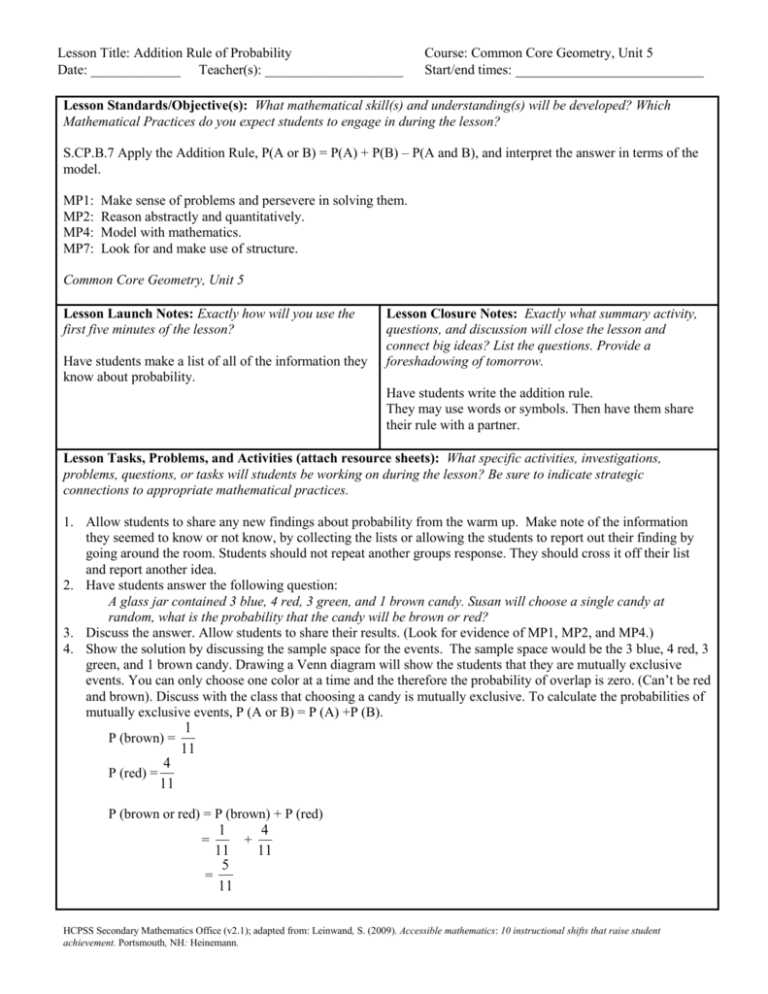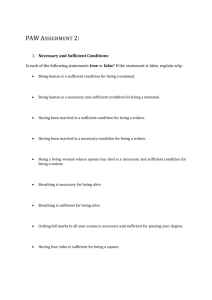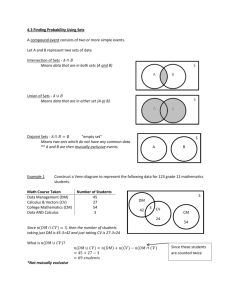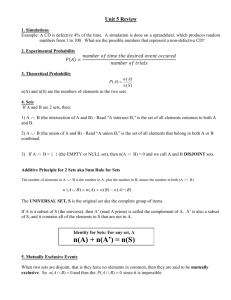S.CP.B.7 Lesson Addition Rule of Probability
advertisement

Lesson Title: Addition Rule of Probability Date: _____________ Teacher(s): ____________________ Course: Common Core Geometry, Unit 5 Start/end times: _________________________ Lesson Standards/Objective(s): What mathematical skill(s) and understanding(s) will be developed? Which Mathematical Practices do you expect students to engage in during the lesson? S.CP.B.7 Apply the Addition Rule, P(A or B) = P(A) + P(B) – P(A and B), and interpret the answer in terms of the model. MP1: MP2: MP4: MP7: Make sense of problems and persevere in solving them. Reason abstractly and quantitatively. Model with mathematics. Look for and make use of structure. Common Core Geometry, Unit 5 Lesson Launch Notes: Exactly how will you use the first five minutes of the lesson? Have students make a list of all of the information they know about probability. Lesson Closure Notes: Exactly what summary activity, questions, and discussion will close the lesson and connect big ideas? List the questions. Provide a foreshadowing of tomorrow. Have students write the addition rule. They may use words or symbols. Then have them share their rule with a partner. Lesson Tasks, Problems, and Activities (attach resource sheets): What specific activities, investigations, problems, questions, or tasks will students be working on during the lesson? Be sure to indicate strategic connections to appropriate mathematical practices. 1. Allow students to share any new findings about probability from the warm up. Make note of the information they seemed to know or not know, by collecting the lists or allowing the students to report out their finding by going around the room. Students should not repeat another groups response. They should cross it off their list and report another idea. 2. Have students answer the following question: A glass jar contained 3 blue, 4 red, 3 green, and 1 brown candy. Susan will choose a single candy at random, what is the probability that the candy will be brown or red? 3. Discuss the answer. Allow students to share their results. (Look for evidence of MP1, MP2, and MP4.) 4. Show the solution by discussing the sample space for the events. The sample space would be the 3 blue, 4 red, 3 green, and 1 brown candy. Drawing a Venn diagram will show the students that they are mutually exclusive events. You can only choose one color at a time and the therefore the probability of overlap is zero. (Can’t be red and brown). Discuss with the class that choosing a candy is mutually exclusive. To calculate the probabilities of mutually exclusive events, P (A or B) = P (A) +P (B). P (brown) = P (red) = 1 11 4 11 P (brown or red) = P (brown) + P (red) 1 4 + 11 11 5 = 11 = HCPSS Secondary Mathematics Office (v2.1); adapted from: Leinwand, S. (2009). Accessible mathematics: 10 instructional shifts that raise student achievement. Portsmouth, NH: Heinemann. Lesson Title: Addition Rule of Probability Course: Common Core Geometry, Unit 5 Date: _____________ Teacher(s): ____________________ Start/end times: _________________________ 5. Discuss any misunderstandings students may have with the problem above. (Look for evidence of MP7.) 6. Have the class answer the following question: Susan thought probability is so much fun that she began to think of more situations. She loves playing cards. She wondered what is the probability of drawing a jack or a heart at random form the deck of cards? 7. Allow students to share and discuss their answers. (Look for evidence of MP2, MP4, and MP7.) 8. Show the solution by discussing the sample space for the event. The sample space being a deck of cards and you are hoping to get a jack or a heart. When discussing the sample space remember to show there are 4 possible jacks and 13 cards that are hearts, but on of the jack cards are a heart and you can not count it twice. Have students develop a Venn diagram to represent the situation. Allow students time to discuss what the solution would be for the probability. What will they do with the card that overlaps? See example of Venn diagram below. Jack and heart (Overlap) Jack Heart With the jacks in one circle and the hearts in the other circle, the dark shaded area would be the jack that is also a heart. Choosing a jack of hearts causes the card to be counted twice. (There is an overlap.) Therefore you need to subtract that probability. Discuss with the class that events are mutually inclusive. To find the probability of mutually inclusive events, P (A or B) = P (A) + P (B) – P (A and B). P (Jack or a Heart) = P (Jack) + P (Heart) – P (Jack of Heart) 4 13 1 + 52 52 52 16 = 52 = 9. Divide the class into groups. Each group will complete the one of the six probability scenarios in a given time the scenario to the next group. Be sure to remind students to determine if the events in each limit and then pass situation are mutually inclusive or exclusive. Continue passing until each group has completed each scenario. of MP1, MP2, MP4, and MP7.) (Look for evidence 10. Allow students to share their answers to the six scenarios. (Look for evidence of MP1, MP2, MP4, and MP7.) Evidence of Success: What exactly do I expect students to be able to do by the end of the lesson, and how will I measure student success? That is, deliberate consideration of what performances will convince you (and any outside observer) that your students have developed a deepened and conceptual understanding. HCPSS Secondary Mathematics Office (v2.1); adapted from: Leinwand, S. (2009). Accessible mathematics: 10 instructional shifts that raise student achievement. Portsmouth, NH: Heinemann. Lesson Title: Addition Rule of Probability Course: Common Core Geometry, Unit 5 Date: _____________ Teacher(s): ____________________ Start/end times: _________________________ Students will be able to apply the addition rule of probability to successfully solve different scenarios. Students will be able to note if a probability is mutually exclusive (disjoint) or not mutually exclusive and use the correct one when solving probability problems. Students will be able to create a probability problem that applies the addition rule of probability. Notes and Nuances: Vocabulary, connections, anticipated misconceptions (and how they will be addressed), etc. Mutually-exclusive Non-mutually exclusive Overlap Students may have trouble seeing the overlap in a probability situation. You can use a deck of cards to visually show a few examples to students who need to see the overlap. Resources: What materials or resources are essential for students to successfully complete the lesson tasks or activities? Homework: Exactly what follow-up homework tasks, problems, and/or exercises will be assigned upon the completion of the lesson? Paper Scenarios copied for group work. Have students write two probability scenarios one that is mutually exclusive and one that is non-mutually exclusive. They need to also provide the answer to their scenarios. Lesson Reflections: How do you know that you were effective? What questions, connected to the lesson standards/objectives and evidence of success, will you use to reflect on the effectiveness of this lesson? Where the students able to successfully complete the scenarios using the addition rule of probability? Can the students generate their own probability problems using the addition rule of probability? Do the students understand the meaning of mutually exclusive events? Howard County Public Schools Office of Secondary Mathematics Curricular Projects has licensed this product under a Creative Commons Attribution-NonCommercial-NoDerivs 3.0 Unported License. HCPSS Secondary Mathematics Office (v2.1); adapted from: Leinwand, S. (2009). Accessible mathematics: 10 instructional shifts that raise student achievement. Portsmouth, NH: Heinemann.










